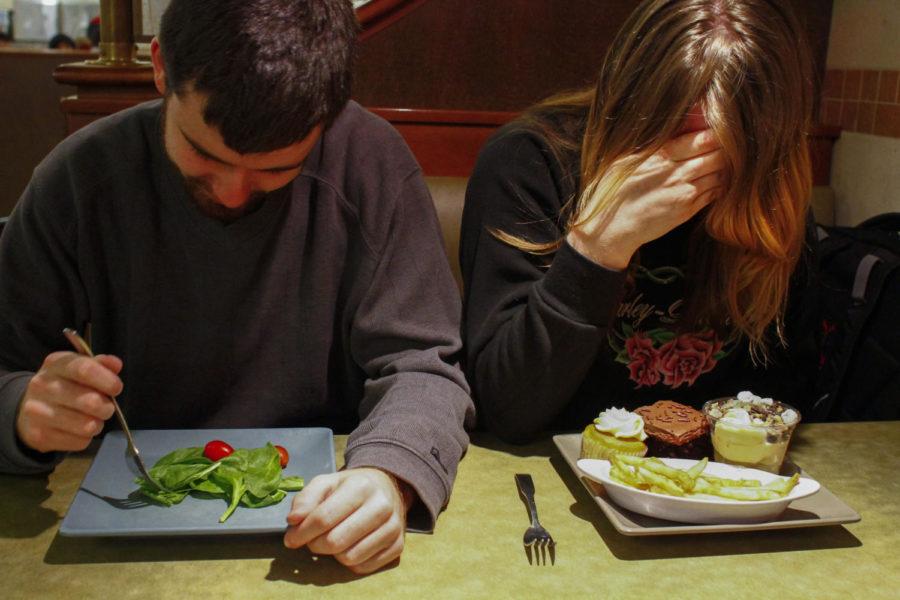The Daily Struggle
According to Brown University’s health center, over 74 percent of females and 46 percent of males suffer from negative body image, which makes it an issue that hits close to home for many ISU students.
November 10, 2014
There are more than 200 classified forms of mental illnesses, with eating disorders having the highest mortality rate of all of them, according to the National Eating Disorders Association, or NEDA. On top of that startling statistic, sufferers of eating disorders are 50 times more likely to commit suicide than the general population, according to the organization Anorexia Nervosa and Associated Disorders, or ANAD.
The NEDA has found that full blown eating disorders typically begin between the ages of 18 and 21, making college a high-risk period for the onset of these disorders. Reasons for this being that college is typically a persons first time away from the watchful eyes of close family members and friends, rendering them the freedom to make decisions on their own regarding food and exercise.
Increased amount of stressors and responsibility can also trigger disordered eating in students. The webpage for the counseling center at The University of Illinois states that, “symptoms usually represent more complex psychological or emotional issues such as anxiety, depression, perfectionism, low self-esteem, trauma, or relational problems with friends or family members,” not just an obsession with weight-loss and food.
Focus on appearance is at an all time high in college, and if someone feels they aren’t meeting societal standards their body image may suffer immensely. Body image incorporates how someone perceives their body visually, how they think others view their body, and how someone talks about their body.
Negative body image can be all consuming and extremely hard to shake. Kelsey Brunson, senior at ISU, felt the pressure to be thin after putting on 70 pounds out of high school. “I was very insecure, I felt like I was never going to be able to get it back off,” said Brunson.
Like many people, the mirror was more friend than foe for Brunson. The constant burden of not feeling good enough took a toll on daily activities. This is when negative body image can turn down a destructive path of disorder eating.
However, fortunately for Brunson, after months of hard work and a new healthier outlook on her appearance, she is happier than ever and says, “Nothing feels better than being comfortable in your own skin.”
According to Brown University’s health center, over 74% of females and 46% of males suffer from negative body image, which makes it an issue that hits close to home for many ISU students. Iowa State has taken notice and is actively pursuing a shift to positive body image by participating in Body Image and Eating Disorders Awareness week, which takes place the last week of February, as well as forming groups that promote a healthy more realistic body ideal.
According to ANAD, “only 10-15% of people with anorexia and bulimia are male,” however, this doesn’t make the disorder any less real for survivors like Kody Larsen. Kody, a senior in Industrial Technology and Occupational Health and Safety, suffered from anorexia nervosa his freshman year at Iowa State.
“It started with 10 pounds, then 20, then 30 and kept going,” said Larsen. “I didn’t want to be around anyone or make any friends, instead I focused on losing more weight and isolating myself.”
Kody is not alone in his struggle, in fact, according to NEDA statistics 10-20% of women and 10% of men on college campuses suffer from eating disorders, and that number is rising.
Another ISU student, junior Morgan Morse, also found her disorder extremely isolating. She avoided social events that involved food and even skipped out on group meetings because, “they had treats there.”
Many people with eating disorders, like Larsen and Morse, found it uncomfortable when confronted with their disorder, “the hardest part was being told I had a disorder by other people. I didn’t know how to react to what people were saying and I didn’t want to change,” said Larsen.
Michelle Roling, certified eating disorder specialist and counselor at Iowa State, highlights the importance of early detection saying, “Early detection can make a big difference in treatment, so DO NOT WAIT!”
If someone suspects a friend or loved one may have an eating disorder Roling suggests reading up on what is helpful and what is not, doing a little bit of research on the disorder, and being compassionate. “You have to decide if there is someone closer to that individual or someone who they might hear the message better from,” says Roling. She also warns that, “Big interventions aren’t the best idea like with other addictions.”
The likelihood of knowing someone on Iowa State’s campus that suffers from an eating disorder is high. According to Roling, 1 in 10 college students have a diagnosable eating disorder. Unfortunately, “You cannot look at someone and know they have a disorder; their outwardly appearance cannot tell you what’s going on inwardly,” says Roling. So knowing when someone is struggling with these disorders can be difficult. The same goes for someone struggling with negative body image.
Iowa State has resources available to students struggling with eating disorders and body image. Student counseling services provides individual counseling along with group counseling sessions.
A new group on campus called BIEDA (body image and eating disorder awareness) offers a welcoming environment for people wanting to raise awareness and increase body acceptance.
If you or someone you know is struggling with an eating disorder, do not ignore it. “It’s never too late to start recovery or return to a treatment team,” affirmed Roling.

















